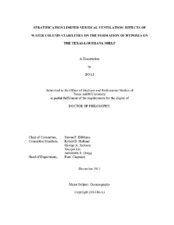| dc.contributor.advisor | DiMarco, Steven F. | |
| dc.creator | Li, Bo | |
| dc.date.accessioned | 2014-05-13T17:23:33Z | |
| dc.date.available | 2014-05-13T17:23:33Z | |
| dc.date.created | 2013-12 | |
| dc.date.issued | 2013-12-02 | |
| dc.date.submitted | December 2013 | |
| dc.identifier.uri | https://hdl.handle.net/1969.1/151781 | |
| dc.description.abstract | I examine the vertical structure of water-column stability and its relationship to near-bottom dissolved oxygen (DO) concentration in the hypoxic zone of the Texas-Louisiana Shelf using observations collected between year 2003 and 2009. A threshold of N=0.06 s^(-1) is defined to represent the lower limit of the stratification strength for existence of hypoxia. An idealized one-dimensional model with parameterized respiration was applied to study stratification structure associated hypoxia development. The simulation results showed that the bottom mixed layer could enhance the bottom DO depletion and favor the development of hypoxia. A secondary pycnocline was above the bottom mixed layer and performed as a barrier to inhibit the vertical extension of hypoxia and vertical DO flux through it. Furthermore, I discussed possible mechanisms causing bottom mixed layer on the continental shelf, including return flow caused by upwelling, inertial motions and tidal currents.
Diapycnal diffusivity was calculated using hourly continuous observations in the hypoxic zone on the Texas-Louisiana Shelf. The estimated time-averaged diapycnal diffusivity was 3 × 10^(-6) m^(2) s^(-1) along the pycnocline. Averaged cross-pycnocline vertical dissolved oxygen flux was calculated in a two-layer stratified water column with subpycnocline hypoxia. The estimated cross-pycnocline dissolved oxygen flux was 156.8 ml l^(-1) d^(-1), which resupplied 45% dissolved oxygen consumption in the subpycnocline layer.
Continuous observations at the South Marsh Mooring showed the first highly resolved observations of short timescale fluctuations in the DO concentrations in the seasonal hypoxic waters on the Louisiana Shelf. There were 19 ventilation events in the DO records with a time period of 1~3 days. Analysis of the time series of DO, salinity and temperature at different levels of the mooring demonstrated that most of the ventilation-intervals were associated with increased vertical mixing, which contributed 58% of the total ventilation intervals. It suggests that mixing events dominate the ventilation-intervals. Comparison of the time derivative of the low-frequency part of the near-bottom DO concentration to observations of the wind and significant wave height suggests that local wind events are responsible for the enhanced vertical mixing. | en |
| dc.format.mimetype | application/pdf | |
| dc.language.iso | en | |
| dc.subject | hypoxia | en |
| dc.subject | stratification, | en |
| dc.title | Stratification Limited Vertical Ventilation: Effects of Water-column Stabilities on the Formation of Hypoxia on the Texas-Louisiana Shelf | en |
| dc.type | Thesis | en |
| thesis.degree.department | Oceanography | en |
| thesis.degree.discipline | Oceanography | en |
| thesis.degree.grantor | Texas A & M University | en |
| thesis.degree.name | Doctor of Philosophy | en |
| thesis.degree.level | Doctoral | en |
| dc.contributor.committeeMember | Hetland, Robert D. | |
| dc.contributor.committeeMember | Jackson, George A. | |
| dc.contributor.committeeMember | Lin, Xiaopei | |
| dc.contributor.committeeMember | Quigg, Antonietta S. | |
| dc.type.material | text | en |
| dc.date.updated | 2014-05-13T17:23:33Z | |


